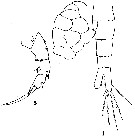|
|
 |
Fiche d'espèce de Copépode |
|
|
Calanoida ( Ordre ) |
|
|
|
Diaptomoidea ( Superfamille ) |
|
|
|
Pseudodiaptomidae ( Famille ) |
|
|
|
Pseudodiaptomus ( Genre ) |
|
|
| |
Pseudodiaptomus forbesi (Poppe & Richard, 1890) (F,M) | |
| | | | | | | Syn.: | Schmackeria forbesi Poppe & Richard, 1890 (p.396, figs.F,M); Marsh, 1933 (p.44, figs.F,M); Shen & Tai, 1962 (p.101, Rem.). | | | | Ref.: | | | Burchardt, 1913, (p.380, fig.F, M: 11E, 12H, Rem. p.392: phylogeny); Sewell, 1948 (p.421); Shen & Lee, 1963 (p.577); Walter, 1986 (p.132); 1986 a (p.503); 1987 (p.367); Orsi & Walter, 1991 (p.553, figs.F,M) |  Issued from : C.D. Marsh in Proc. U.S. natn. Mus., 1933, 82 (18) (2959). [Pl. 21, figs.5, 7]. As Schmackeria forbesi. Female (from Yangtze Kiang): 5, P5; 7, urosome with egg sac (dorsal).
|
 Issued from : C.D. Marsh in Proc. U.S. natn. Mus., 1933, 82 (18) (2959). [Pl. 22, fig.4]. As Schmackeria forbesi. After Burckhardt, 1913. Male: 4, P5.
| | | | | Ref. compl.: | | | Ohtsuka & al., 1995 (p.159); Cordell & al., 1997 (p.2, invasive species); Mauchline, 1998 (p.507); Choi & al., 2005 (p.710: Tab.III); Humphrey, 2008 (p.64, 84: Appendix A); Ohtsuka & al., 2008 (p.115, Table 6); Cordell & al., 2008 (p.753); Bollens & al., 2011 (p.1358, Table III, fig.8); DiBacco & al., 2012 (p.483, Table S1, ballast water transport); Bollens & al., 2012 (p.101, fig.2, Table 1, species competition); Kimmerer & al., 2014 (p.722, reproduction , growth vs food); Sabia & al., 2015 (p.460, Table 3, Rem.) | | | | NZ: | 3 | | |
|
Carte de distribution de Pseudodiaptomus forbesi par zones géographiques
|
| | | | | |  Carte de 1996 Carte de 1996 | |
 Issued from : M. Winder, A.D. Jassby & R.M. Nally in Ecology Letters, 2011, 14. [p.753, Fig.3, d]. Issued from : M. Winder, A.D. Jassby & R.M. Nally in Ecology Letters, 2011, 14. [p.753, Fig.3, d].
Historical abundances of introduced species in the upper San Francisco Estuary between 1972 and 2009.
Adult stages are shown because immature stages were not continuously identified.
Pseudodiaptomus spp. is dominated by P. forbesi, whereas P. marinus contributed in small numbers. |
| | | | Loc: | | | China Seas (East China Sea, South China Sea, Yangtze-Kiang Riv.), Japan, California, San Francisco Estuary | | | | N: | 12 | | | | Lg.: | | | (1062) F: 1,20-1,35; M: 1,20; {F: 1,20-1,35; M: 1,20} | | | | Rem.: | forme récoltée à l'origine en eau douce près de Shanghaï, transportée par les ballasts des navires en Californie (Sacramento Estuary).
Incomplete data.
Voir aussi les remarques en anglais | | | Dernière mise à jour : 02/09/2019 | |
|
|
 Toute utilisation de ce site pour une publication sera mentionnée avec la référence suivante : Toute utilisation de ce site pour une publication sera mentionnée avec la référence suivante :
Razouls C., Desreumaux N., Kouwenberg J. et de Bovée F., 2005-2025. - Biodiversité des Copépodes planctoniques marins (morphologie, répartition géographique et données biologiques). Sorbonne Université, CNRS. Disponible sur http://copepodes.obs-banyuls.fr [Accédé le 26 décembre 2025] © copyright 2005-2025 Sorbonne Université, CNRS
|
|
 |
 |






